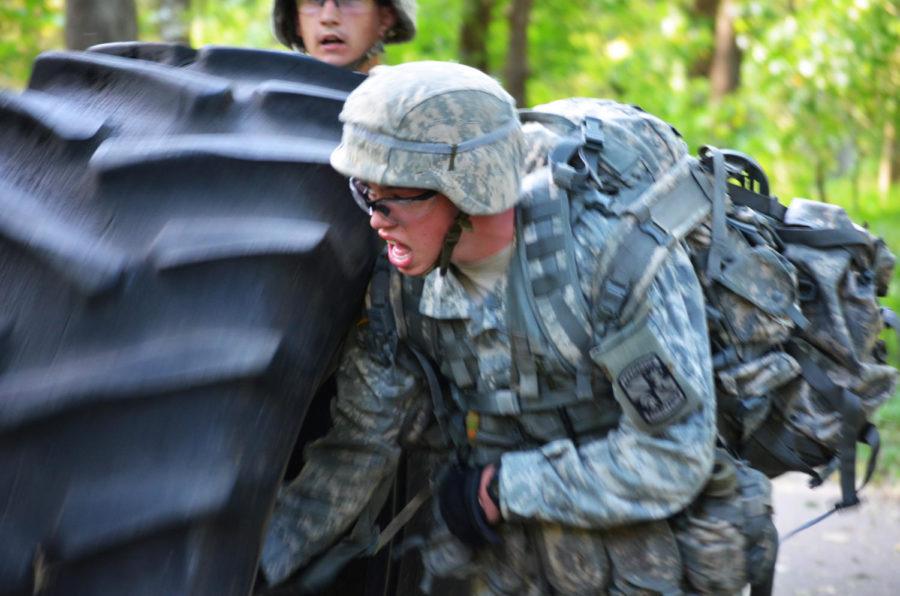Real soldiers, toy guns, AROTC trains at Brookside
September 16, 2015
Two cadets shaded themselves from the sun as they awaited the arrival of the rest of their platoon.
Rubber rifles were laid out in front of them and a fake log was by their side. Two giant tires and Platoon Sgt. Mason Swanstrom pulled into the parking lot.
The Army ROTC company divides into five platoons every Wednesday and participates in team building exercises to help contracted and non-contracted cadets grow together as a company, platoon and squad.
Swanstrom, along with squad leaders Francis Kelly, Benjamin Baur and Brad Schuler took attendance in an informal formation and gave a short speech about safety. The cadets then began the team building activities that lasted an hour and a half.
From the break of formation, cadets were given five minutes to gather the 25 rifles, one of the tires and two gurneys along with other miscellaneous gear. Cadets followed the park trail at Brookside Park to 13th Street, which is more than a mile walk round-trip.
Beginning with four cadets on the tire and two cadets carrying the log, the 14 cadets walked along the path with words of support that contrasted the insistence of rushing as Swanstrom shouted that they were taking too long. The cadets use this training to help better prepare them for their futures in the Army.
Cadets broke into two groups of seven at the first station. The first mission was to run into the woods and gather objects that squad leader Baur had arranged for the exercise. If the cadets came back with the wrong objects, they would have to keep going back before moving on.
The other cadets pulled security of a 360-degree radius. This means they laid on the ground and pointed their rifles at potential enemies.
Before moving on to the next section, one cadet suffered a simulated shot in the arm and broken leg. Two other cadets carried him on a gurney.
Phrases such as “keep moving” or “hold back” were shouted as the cadets communicated to keep the platoon from separating.
As the cadets trekked on, a faux bridge on the sidewalk was sabotaged and the cadets had to find an alternative way to cross without losing equipment in the water.
They had 60 seconds to plan before a simulated enemy attacked.
While crossing the bridge designed with chalk, joggers running through received high fives from the cadets.
The third squad of the platoon was first to cross the bridge, but because of a lack of security, it suffered two casualties. A third cadet, Benjamin McCully, junior in global resource systems, died in the simulation because he forgot his rifle while crossing.
Cadets then carried their wounded peers to the next station, where another cadet was shot in the leg.
The final station, which was less rigorous, allowed the cadets to bond by having them grab hands randomly and form a circle without letting go.
McCully said these exercises give the cadets a sense of camaraderie. He said that when friends have unpleasant experiences it brings them closer together and allows them to open up as a team and respond better.
“Misery loves company,” McCully added.
Following the last exercise, the platoon gathered its things and recouped at the beginning.
Swanstrom had the cadets take a knee in a horseshoe formation and he, Kelly, Baur and Schuler discussed the negatives and positives of the lab.
“What did you guys think of the lab?” Swanstrom asked the cadets. “What could we have done better or differently?”
After discussing a few hiccups surrounding the ability to go from a dead stop to moving on, the squad leaders met with their squads to work on after action reports.
“If time is an essence, find out what you need to do and do it,” Kelly said.

















